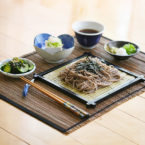Description
Soba noodles, a cornerstone of Japanese cuisine, are made from buckwheat flour, which gives them a characteristic nutty flavor and firm texture. Traditionally enjoyed cold with a dipping sauce or in a hot broth, they are not only delicious but also packed with nutrients. Soba have a special place in Japanese food culture, often eaten during celebrations or as a year-end meal to welcome the New Year.
Ingredients
Units
Scale
For the Soba Noodles:
- 2 quarts (8 cups or about 1.9 liters) Water
- 12 oz (340 g) Dried Soba/Buckwheat Noodles
- 1 1/2 cups (360 ml) Dashi Stock
- 5 tablespoons Soy Sauce
- 3 tablespoons Mirin (Japanese sweet cooking wine)
- 1 tablespoon Sugar
- 1 sheet Toasted Seaweed (Nori), cut into thin strips
- 2 Green Onions (Scallions), finely chopped
- 4 teaspoons Wasabi Powder (mix with water to form a paste)
- 2 teaspoons Grated Daikon (Japanese Radish)
Instructions
Preparing the Soba Noodles:
- Boil Water: Fill a large pot with 2 quarts of water and bring it to a rolling boil over high heat.
- Cook Noodles: Carefully add the soba noodles to the boiling water, spreading them out. Stir gently to ensure they do not stick together. Wait for the water to return to a full boil, then lower the heat slightly to maintain a steady but gentle boil. Cook according to the package instructions, usually about 4-8 minutes.
- Cold Water Shock: If the noodles start boiling over, add a cup of cold water to lower the temperature briefly. This technique, known as ‘yudane’, helps to cook the noodles evenly.
- Check Doneness: Taste a noodle or check its texture; it should be firm yet tender, not mushy.
- Rinse and Cool: Once cooked, pour the noodles into a colander and rinse them thoroughly under cold running water. This stops the cooking process and removes excess starch, ensuring the noodles are cool and firm.
- Drain Well: Shake off the excess water and transfer the noodles to a tray. Cover with a damp kitchen towel to prevent them from drying out while you prepare the other components.
Preparing the Dipping Sauce (Tsuyu):
- Dashi Stock: Dashi is a fundamental Japanese stock often made from kelp (kombu) and dried bonito fish flakes (katsuobushi). For beginners, instant dashi granules are a practical choice. Follow the package instructions to prepare 1 1/2 cups of dashi. Typically, you’ll dissolve about 1 teaspoon of granules in 1 1/2 cups of hot water.
- Combine Ingredients: In a medium saucepan, mix the prepared dashi, soy sauce, mirin, and sugar. Place over medium-high heat and stir until the sugar dissolves. Remove from heat and let the sauce cool down. You can refrigerate it for a refreshing, cold dip.
Arranging the Dish:
- Nori and Garnishes: Cut the nori sheet into thin strips using kitchen scissors. Chop the green onions finely and prepare wasabi paste by mixing the wasabi powder with a little water. Let it stand to develop its flavor.
- Serve: Place the cooled noodles on individual plates or a communal serving dish. Sprinkle nori strips over the noodles. Serve the dipping sauce in small bowls or cups, and provide wasabi, grated daikon, and green onions on the side for guests to add according to their taste.
- Enjoy: Traditionally, diners will add their preferred garnishes to the dipping sauce, then dip small bundles of soba into the sauce as they eat. Slurping is encouraged — it enhances the flavors and cools the noodles!
Notes
- Don’t overcook soba; they should be firm to the bite.
- Rinse noodles thoroughly to prevent a gummy texture.
- Adjust the dipping sauce’s flavor according to your preference.
- For a spicy kick, add more wasabi as desired.
- Prep Time: 15 mins
- Cook Time: 20 mins
- Category: Main Course
- Method: Boiling
- Cuisine: Japanese
